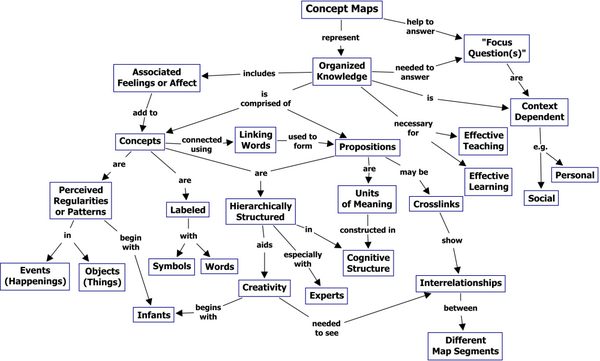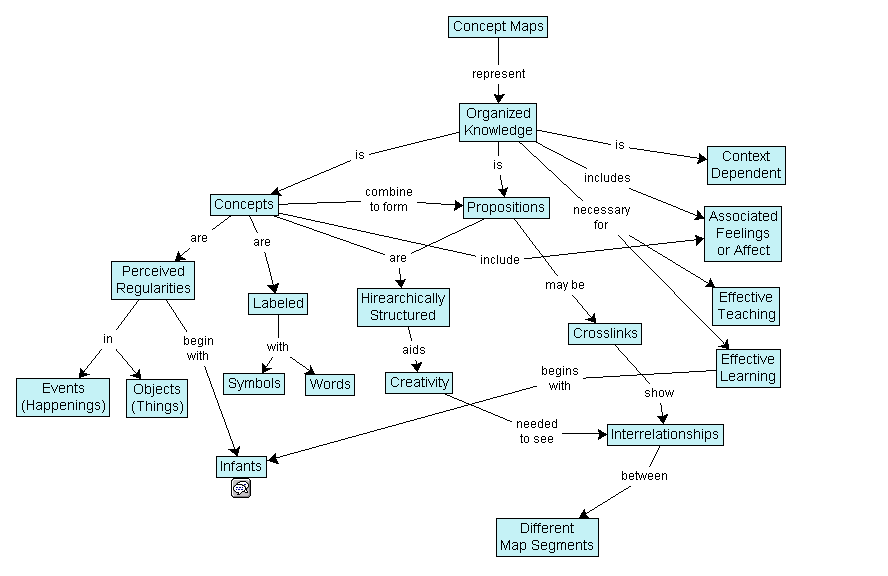Concept map: Difference between revisions
m (using an external editor) |
m (using an external editor) |
||
| Line 46: | Line 46: | ||
[[image:CmapAboutCmaps-medium.png|thumb|none|600px|A concept map showing the key features of concept maps. Concept maps tend to be read progressing from the top downward. Source: Novak, J. D. & A. J. Cañas, The Theory Underlying Concept Maps and How to Construct Them, Technical Report IHMC CmapTools 2006-01, Florida Institute for Human and Machine Cognition, 2006", available at: http://cmap.ihmc.us/Publications/ResearchPapers/TheoryUnderlyingConceptMaps.pdf.]] | [[image:CmapAboutCmaps-medium.png|thumb|none|600px|A concept map showing the key features of concept maps. Concept maps tend to be read progressing from the top downward. Source: Novak, J. D. & A. J. Cañas, The Theory Underlying Concept Maps and How to Construct Them, Technical Report IHMC CmapTools 2006-01, Florida Institute for Human and Machine Cognition, 2006", available at: http://cmap.ihmc.us/Publications/ResearchPapers/TheoryUnderlyingConceptMaps.pdf.]] | ||
An other version of this map can be found in [http://en.wikipedia.org/wiki/Concept_Map Wikipedia] | An other, simpler version of this map can be found in [http://en.wikipedia.org/wiki/Concept_Map Wikipedia] | ||
[[image:Conceptmap.gif|frame|none|Example concept map, created using IHMC CmapTools. Copyright: Wikipedia - GFDL]] | [[image:Conceptmap.gif|frame|none|Example concept map, created using IHMC CmapTools. Copyright: Wikipedia - [http://en.wikipedia.org/wiki/Wikipedia:Text_of_the_GNU_Free_Documentation_License GFDL]]] | ||
== Concept mapping in education == | == Concept mapping in education == | ||
Revision as of 11:44, 18 August 2007
Definition
- A concept map is a graphical representation of a person's (student's) knowledge of a domain. (Alpert & Grueneberg, 2001).
- Concept maps are tools for organizing and representing knowledge. They include concepts, usually enclosed in circles or boxes of some type, and relationships between concepts or propositions, (indicated by a connecting line and linking word) between two concepts. Linking words on the line specify the relationship between the two concepts. (Concept Maps: What the heck is this?, retrieved 11:44, 9 August 2007 (MEST).)
- A concept map is a kind of visualization.
- The arrangement of major concepts from a text or lecture into a visual arrangement. Lines are drawn between associated concepts, and relationships between the connected concepts are named. These concept maps reveal the structural pattern in the material and provide the big picture. ( Diane Ehrlich retrieved 21:08, 3 July 2006 (MEST))
- Concept mapping is a technique for visualizing the relationships between different concepts. A concept map is a diagram showing the relationships in between concepts. Concepts are connected with labelled arrows, in a downward-branching hierarchical structure. The relationship between concepts is articulated in linking phrases, e.g., "gives rise to", "results in", "is required by," or "contributes to". ( Wikipedia - Concept Map retrieved 21:08, 3 July 2006 (MEST) )
Typology of concept maps
Concept maps can be defined in a more narrow sense as by Novak & Cañas (2006) - see below - or more generally as a drawing that somehow connects concepts.
- According to structural properties
- Spider-like maps with labelled arcs (the typical concept map)
- Hierarchical maps (like mind maps)
- Formal maps like UML diagrams,
- Formal semantic networks, Topic maps, etc. I.e. drawings are associated with a formal symbolic representation.
- Concept definition maps
- According to purpose
(Jan Lanzing, retrieved 11:44, 9 August 2007 (MEST))
- to generate ideas (brain storming, etc.);
- to design a complex structure (long texts, hypermedia, large web sites, etc.);
- to communicate complex ideas;
- to aid learning by explicitly integrating new and old knowledge;
- to assess understanding or diagnose misunderstanding.
- The typical concept map
The most typical concept is a map that contains
- concepts,
- directed and labelled arcs.
- In addition, concepts are presented in hierarchical manner, the most general concepts on top.
I.e. Novak and Cañas (2006) two of leading concept map researchers define concept maps in their famous Theory Underlying Concept Maps and How to Construct Them paper defined concept maps like this: {{quotation|Concept maps are graphical tools for organizing and representing knowledge. They include concepts, usually enclosed in circles or boxes of some type, and relationships between concepts indicated by a connecting line linking two concepts. Words on the line, referred to as linking words or linking phrases, specify the relationship between the two concepts. We define concept as a perceived regularity in events or objects, or records of events or objects, designated by a label. The label for most concepts is a word, although sometimes we use symbols such as + or %, and sometimes more than one word is used. Propositions are statements about some object or event in the universe, either naturally occurring or constructed. Propositions contain two or more concepts connected using linking words or phrases to form a meaningful statement. Sometimes these are called semantic units, or units of meaning.
Here is Novak's and Cañas' concept map explaining concept maps (this image may be under copyright):

An other, simpler version of this map can be found in Wikipedia

Concept mapping in education
Rationales for concept mapping in education are based on several connected ideas:
- The general writing-to-learn argument (writing favors making connections)
- Concept maps can prepare writing and assist in exploration and reading.
- Concept maps are an assessment tool for the teacher.
“Concept map tools should be able to represent multiple types or forms of knowledge, not merely text-based propositions. Specifically, incorporating multimedia in concept mapping software should (a) provide for greater cognitive fidelity in student-constructed concept maps, allowing students to more comprehensively represent their knowledge in ways similar to their own cognitive representations; (b) offer the illustrative advantages of dynamic visual imagery and audio to students learning new concepts and domains; (c) provide the capability of reifying concepts with concrete instances that can be seen and heard; (d) offer richer expressive power for concept map authors; (e) provide for a more engaging student experience; and (f) better capitalize on functionality available in modern personal computers.” (Alpert & Grueneberg, 2001), retrieved, 17:17, 15 September 2006 (MEST).
“[...] the primary rationale for concept mapping is that students must establish connections between bits of given information, again in a visible medium. Concept mapping can stimulate students to demonstrate relationships among facts and concepts, demonstrate relationships between lower-order and higher-order concepts, and demonstrate relationships between old and new information within the students' own cognitive structures. It is noteworthy that writing of any kind, not just journaling or concept mapping, makes many of the same demands and that the literature on cohesion in writing (Halliday & Hasan, 1976; Lovejoy & Lance, 1991) complements the literature on concept mapping. Concept maps, then, not only serve the same ends as writing (making connections) but also serve as a valuable means to writing (as a prewriting or planning tool) and as a valuable means for the teacher to assess learning-in-progress.” (Germann & Young-soo, 2001:321).
However, findings reported from these authors who studied whether electronic journaling plus electronic concept mapping lead to heigtheing reflection in science classes for future science teachiers, are not overwhelming: “It was hoped that use of electronic journaling and concept mapping would promote sustained reflection (as demonstrated in the quality of revised concept maps and quality of revised drafts of the culminating paper). On the surface we were disappointed. [...] This lack of demonstrated changed in their concept maps leads us to believe that most students were doing all they could to absorb new ideas and begin to make sense of them. If, however, reflection stems from certain habits of questioning and from heightened skepticism and discrimination of sources of evidence, then most students displayed many behavioral change”. (Germann & Young-soo, 2001: 327).
Software
(not complete)
- Free standalone programs
- IHMC CmapTools. Freeware, multi-platform. Joseph D. Novak, the inventor of concept maps is part of the team at the Institute for Human and Machine Cognition (IHMC). DSchneider recommends this tool)
- FreeMind (Wikipedia entry) is a free mind mapping application written in Java. Various export formats. Integrates with some Wikis .
- PIViT, made for educational use.
- [VUE] from the Visual Understanding Environment (VUE) project at Tufts UIT Academic Technology. VUE provides a visual environment for structuring, presenting, and sharing digital information. Using VUE's concept mapping interface, faculty and students design semantic networks of digital resources drawn from digital libraries, local and remote file systems and the Web. The resulting content maps can then be viewed and exchanged online.
- MOTPlus, general purpose, ontology and learning design concept map editor (free for non-commercial use).
- Free online programes
- MindMeister is an online mind-mapping service (free, at least beta version of Feb 2007)
- Commercial
- Nova Mind Mind Map-like tool
- Inspiration
- MindJet
- Commercial online programs
- The Brain (through the web)
Links
Indexes and bibliographies
- The Cmap Tools Home page has links that you can follow, e.g. to Novak and Cañas's good introduction and to all associated Research Publications (most are online)
- The Concept Mapping Homepage including the excellent W.A. Lanzing's Concept Mapping Bibliography
Introductions
- Concept map (Wikipedia Article)
- Introduction to Concept Maps. Includes tips for learners. University of Illinois at Urbana-Champaign.
- http://en.wikipedia.org/wiki/Concept_Map
- Organizing Your Research, Map Your Concepts by Martha Johansen, Humbolt State University.
- Concept Definition Map, FOR-PD's Reading Strategy of the Month.
- The importance of the "more important concept" in a concept map or "the most relevant concepts
References
(rather see bibliographis above ... )
- Alpert, Sherman R. and Keith Grueneberg (2001), Multimedia in Concept Maps: A Design Rationale and Web-Based Application, Proceedings of ED-MEDIA 2001, HTML
- Cañas, A. J., Ford, K. M., Novak, J. D., Hayes, P., Reichherzer, T., & Suri, N. (2001). Online concept maps: Enhancing collaborative learning by using technology with concept maps. The Science Teacher, 68(4), 49-51.
- Germann, P., & Young-soo, K. (2001). Heightening reflection through dialogue: A case for electronic journaling and electronic concept mapping in science classes. Contemporary Issues in Technology and Teacher Education, [Online serial], 1 (3) . Available: HTML/PDF
- Halliday, M.A.K., & Hasan, R. (1976). Cohesion in English . London: Longman.
- Lovejoy, K.B., & Lance, D.M. (1991). Information management and cohesion in the study of written discourse. Linguistics and Education, 3, 251-273.
- Luckie Douglas, Concept Maps: What the heck is this? Excerpted, rearranged (and annotated) from an online manuscript by Joseph D. Novak, Cornell University (http://cmap.coginst.uwf.edu/info/, webpage HTML, , retrieved 11:44, 9 August 2007 (MEST).
- Buzan, T. (1995). The MindMap book. (2 ed.). London, UK: BBC Books.
- Jonassen, D.H., Beissner, K., & Yacci, M.A. (1993). Structural knowledge: Techniques for conveying, assessing, and acquiring structural knowledge. Hillsdale, NJ: Lawrence Erlbaum Associates.
- Lawson, M. J. (1994). Concept Mapping. In T. Husén & T. N. Postlethwaite (Eds.), The international encyclopedia of education (2nd ed., Vol. 2, pp. 1026-1031). Oxford: Elsevier Science.
- Novak, J.D. (1991). Clarify with concept maps: A tool for students and teachers alike. The Science Teacher, 58(7), 45-49.
- Novak, J. D. (1993). How do we learn our lesson? : Taking students through the process. The Science Teacher, 60(3), 50-55.
- Novak, Joseph D. & Alberto J. Cañas (2006). The Theory Underlying Concept Maps and How to Construct Them, Technical Report IHMC CmapTools 2006-01, Florida Institute for Human and Machine Cognition, HTML (PDFs also available). Recommended for introductory reading. (in case the URL changes see [1]
- Yensen, Jack, Strategies for Learning - from Concept Maps to Learning Objects and Books to Wooks, Webpage, [2], , retrieved 11:44, 9 August 2007 (MEST).